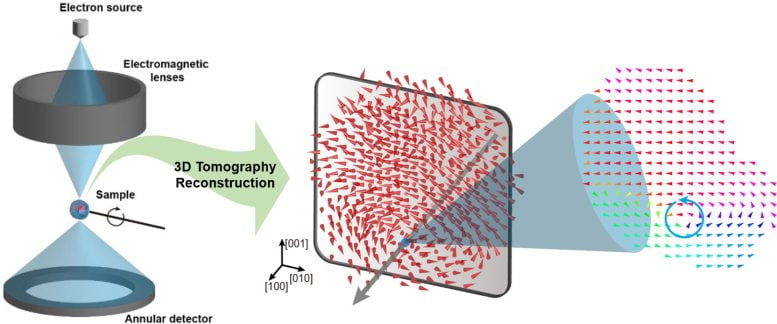Researchers from KAIST, in collaboration with many institutions, have experimentally confirmed the three-dimensional vortex polarization distribution inside ferroelectric nanoparticles. Using atomic electron tomography, they mapped the positions of atoms in barium titanate nanoparticles and calculated the internal polarization distribution. This finding confirms theoretical predictions made 20 years ago and has potential for the development of ultra-high-density memory devices.
AND KAISTThe research team led successfully demonstrated an intrinsic three-dimensional polarization distribution in ferroelectric nanoparticles, paving the way for advanced memory devices capable of storing more than 10,000 times more data than current technologies.
Materials that remain magnetized independently without the need for an external magnetic field are called ferromagnets. Similarly, ferroelectrics can maintain a polarized state by itself, without any external electric field, serving as an electrical equivalent to ferromagnets.
It is well known that ferromagnets lose their magnetic properties when they are reduced to nano sizes below a certain threshold. What happens when ferroelectrics are similarly extremely small in all directions (ie into a zero-dimensional structure such as nanoparticles) has long been a matter of contention.
The research team led by Dr. Yongsoo Yangem of the Department of Physics at KAIST experimentally elucidated the three-dimensional vortex-shaped polarization distribution inside ferroelectric nanoparticles for the first time through international research in collaboration with POSTECH, SNU, KBSI, LBNL, and the University of Arkansas.
About 20 years ago Prof. Laurent Bellaiche (now at the University of Arkansas) and his colleagues theoretically predicted that a unique form of polarization distribution, arranged in a toroidal vortex shape, could occur inside ferroelectric nanodots. They also suggested that if this vortex distribution could be properly controlled, it could be applied to ultra-high-density memory devices with capacities more than 10,000 times larger than existing ones. However, experimental clarification has not been achieved due to the difficulty of measuring the three-dimensional polarization distribution in ferroelectric nanostructures.
Advanced techniques in electron tomography
A research team at KAIST successfully solved this 20-year-old challenge by implementing a technique called atomic electron tomography. The technique works by acquiring atomic-resolution transmission electron microscope images of nanomaterials from multiple tilt angles and then reconstructing them back into three-dimensional structures using advanced reconstruction algorithms. Electron tomography can be thought of as essentially the same method as CT scans used in hospitals to three-dimensionally image internal organs; the KAIST team uniquely modified it for nanomaterials using an electron microscope on a single-atom level.

Three-dimensional polarization distribution of BaTiO3 nanoparticles revealed by atomic electron tomography. (Left) Schematic of the electron tomography technique, which involves taking transmission electron microscope images at multiple tilt angles and reconstructing them into 3D atomic structures. (Middle) Experimentally determined three-dimensional polarization distribution inside a BaTiO3 nanoparticle using atomic electron tomography. A vortex structure is clearly visible at the bottom (blue dot). (Right) Two-dimensional cross-section of the polarization distribution, thin slices at the center of the vortex, with color and arrows together indicating the direction of polarization. A distinct vortex structure can be observed.
Using atomic electron tomography, the team completely measured the positions of cation atoms inside nanoparticles of barium titanate (BaTiO3), a known ferroelectric material, in three dimensions. From precisely determined 3D atomic arrangements, they were able to further calculate the internal three-dimensional polarization distribution at the level of a single atom. Analysis of the polarization distribution revealed experimentally for the first time that topological polarization arrangements including vortices, antivortices, skyrmions and the Bloch point occur inside 0-dimensional ferroelectrics, as theoretically predicted 20 years ago. Furthermore, it was also found that the number of internal vortices can be controlled depending on their size.
Prof. Sergey Prosandeev and Prof. Bellaiche (who with other collaborators proposed the arrangement of polar vortices theoretically 20 years ago) joined this collaboration and further proved that the results of the distribution of vortices obtained from experiments are in agreement with theoretical calculations.
It is expected that controlling the number and orientation of these polarization distributions can be used in the next generation of high-density memory devices that can store more than 10,000 times more information in a device of the same size compared to existing ones.
Dr. Yang, who led the research, explained the significance of the results: “This result suggests that simply controlling the size and shape of ferroelectrics, without having to tune the substrate or surrounding environmental effects such as epitaxial strain, can manipulate ferroelectric vortices or other topological arrangements at the nanoscale . Further research could then be applied to the development of a new generation of ultra-high-density memory.”
Reference: “Revealing the Three-Dimensional Ordering of Polar Topology in Nanoparticles” by Chaehwa Jeong, Juhyeok Lee, Hyesung Jo, Jaewhan Oh, Hionsuck Baik, Kyoung-June Go, Junwoo Son, Si-Young Choi, Sergey Prosandeev, Laurent Bellaiche, and Yongsoo Yang, 8 . May 2024, The nature of communication.
DOI: 10.1038/s41467-024-48082-x
The study was mainly supported by grants from the National Research Foundation of Korea (NRF) funded by the Korean government (MSIT).